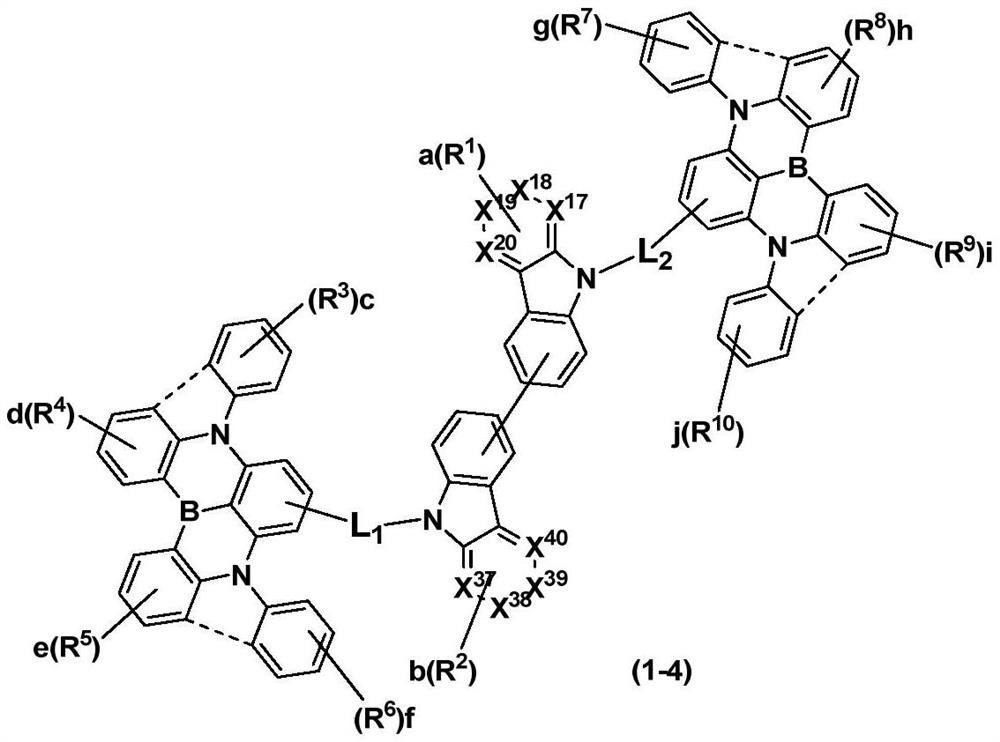Novel boron-containing organic electroluminescent material and application thereof
A technology selected from compounds of the general formula, applied in the field of boron-containing organic compounds, can solve problems such as weak electron transport ability, achieve the effect of improving electron transport ability and benefiting luminous efficiency
- Summary
- Abstract
- Description
- Claims
- Application Information
AI Technical Summary
Problems solved by technology
Method used
Image
Examples
preparation example Construction
[0041] Preparation of Intermediate M5-1:
[0042]Add carbazole (38.1g, 227.9mmol, 2.2eq), 1-fluoro-3,5-dibromobenzene (20g, 103.60mmol, 1eq), cesium carbonate (148.5g, 455.8mmol, 4.5eq), N,N-dimethylformamide (600ml), reacted overnight at 120°C under nitrogen protection. (PE:EA=40:1, product Rf=0.5)
[0043] Stop heating, after cooling to room temperature, add 500ml of water and stir for 10min, a large amount of light white solid precipitates, suction filtration, PE:EA=40:1, column chromatography, 38.6g of white solid is obtained.
[0044] Preparation of Intermediate M5-2:
[0045] At room temperature, M5-1 (60.9g, 125mmol, 2.5eq), 3,3-alpha-carboline (16.6g, 50mmol, 1eq), Pd 2 (dba) 3 (2.54g, 2.5mmol, 0.05eq), s-Phos (2.05g, 5mmol, 0.1eq), sodium tert-butoxide (21.6g, 225mmol, 4.5eq), xylene (500ml) joins in the 1000ml one-necked bottle, Nitrogen gas was pumped three times, heated to 130°C and reacted overnight. The reaction solution was cooled to room temperature, mixe...
Embodiment approach
[0079]The OLED includes a first electrode and a second electrode, and a layer of organic material between the electrodes. The organic material can in turn be divided into regions. For example, the organic material layer may include a hole transport region, a light emitting layer, and an electron transport region.
[0080] In particular embodiments, a substrate may be used either below the first electrode or above the second electrode. The substrates are all glass or polymer materials with excellent mechanical strength, thermal stability, water resistance and transparency. In addition, a thin-film transistor (TFT) may be provided on a substrate for a display.
[0081] The first electrode may be formed by sputtering or depositing a material used as the first electrode on the substrate. When the first electrode is used as the anode, oxide transparent conductive materials such as indium tin oxide (ITO), indium zinc oxide (IZO), tin dioxide (SnO2), zinc oxide (ZnO) and any combi...
Embodiment 1
[0102] The preparation process of the organic electroluminescent device in this example is as follows:
[0103] The glass plate coated with the ITO transparent conductive layer is ultrasonically treated in a commercial cleaning agent, rinsed in deionized water, ultrasonically degreased in acetone: ethanol mixed solvent, baked in a clean environment until the water is completely removed, and then cleaned with ultraviolet light. Light and ozone cleaning, and bombardment of the surface with a beam of low-energy cations;
[0104] Place the above-mentioned glass substrate with the anode in a vacuum chamber, and evacuate to 1×10 -5 ~9×10 -3 Pa, vacuum-deposit HI-3 on the above-mentioned anode layer film as a hole injection layer, the evaporation rate is 0.1nm / s, and the evaporation film thickness is 10nm;
[0105] Vacuum-deposit HT-2 on the hole injection layer as the hole transport layer of the device, the evaporation rate is 0.1nm / s, and the total film thickness is 80nm;
[010...
PUM
 Login to View More
Login to View More Abstract
Description
Claims
Application Information
 Login to View More
Login to View More - R&D
- Intellectual Property
- Life Sciences
- Materials
- Tech Scout
- Unparalleled Data Quality
- Higher Quality Content
- 60% Fewer Hallucinations
Browse by: Latest US Patents, China's latest patents, Technical Efficacy Thesaurus, Application Domain, Technology Topic, Popular Technical Reports.
© 2025 PatSnap. All rights reserved.Legal|Privacy policy|Modern Slavery Act Transparency Statement|Sitemap|About US| Contact US: help@patsnap.com



